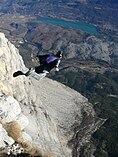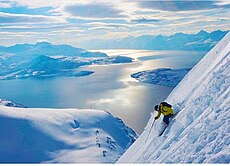Extreme sport
Action sports,adventure sportsorextreme sportsareactivitiesperceived as involving a high degree of risk of injury or death.[1][2][3]These activities often involve speed, height, a high level of physical exertion and highly specialized gear.[1]Extreme tourismoverlaps with extreme sport. The two share the same main attraction, "adrenaline rush"caused by an element ofrisk,and differ mostly in the degree of engagement andprofessionalism.
Definition[edit]
There is no precise definition of an 'extreme sport' and the origin of the term is unclear but it gained popularity in the 1990s when it was picked up by marketing companies to promote theX Gamesand when theExtreme Sports Channeland Extreme International launched. More recently, the commonly used definition from research is "a competitive (comparison or self-evaluative) activity within which the participant is subjected to natural or unusual physical and mental challenges such as speed, height, depth or natural forces and where fast and accurate cognitive perceptual processing may be required for a successful outcome" by Dr. Rhonda Cohen (2012).[4][5]
While the use of the term "extreme sport" has spread everywhere to describe a multitude of different activities, exactly which sports are considered 'extreme' is debatable. There are, however, several characteristics common to most extreme sports.[6]While they are not the exclusive domain of youth, extreme sports tend to have a younger-than-average target demographic. Extreme sports are also rarely sanctioned by schools for theirphysical educationcurriculum.[7]Extreme sports tend to be more solitary than many of the popular traditional sports[8](rafting and paintballing are notable exceptions, as they are done in teams).
Activities categorized by media as extreme sports differ from traditionalsportsdue to the higher number of inherently uncontrollable variables. These environmental variables are frequently weather and terrain-related, including wind, snow, water and mountains. Because these natural phenomena cannot be controlled, they inevitably affect the outcome of the given activity or event.
In a traditional sporting event, athletes compete against each other under controlled circumstances. While it is possible to create a controlled sporting event such as X Games, there are environmental variables that cannot be held constant for all athletes. Examples include changing snow conditions forsnowboarders,rock and ice quality forclimbers,and wave height and shape forsurfers.
Whilst traditional sporting judgment criteria may be adopted when assessing performance (distance, time, score, etc.), extreme sports performers are often evaluated on more subjective and aesthetic criteria.[9]This results in a tendency to reject unified judging methods, with different sports employing their own ideals[10]and indeed having the ability to evolve their assessment standards with new trends or developments in the sports.
History[edit]
The origin of the divergence of the term "extreme sports" from "sports" may date to the 1950s in the appearance of a phrase usually, but wrongly, attributed toErnest Hemingway.[11]The phrase is;
There are only three sports: bullfighting, motor racing, and mountaineering; all the rest are merely games.
The implication of the phrase was that the word "sport" defined an activity in which one might be killed, other activities being termed "games." The phrase may have been invented by either writerBarnaby Conrador automotive authorKen Purdy.[11]
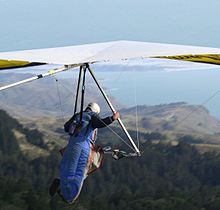
TheDangerous Sports ClubofOxford University,Englandwas founded by David Kirke, Chris Baker, Ed Hulton andAlan Weston.They first came to wide public attention by inventing modern daybungee jumping,by making the first modern jumps on 1 April 1979, from theClifton Suspension Bridge,Bristol, England.They followed the Clifton Bridge effort with a jump from theGolden Gate BridgeinSan Francisco, California(including the first female bungee jump by Jane Wilmot), and with a televised leap from theRoyal GorgeSuspension Bridge inColorado,sponsored by and televised on the popularAmericantelevision programThat's Incredible!Bungee jumpingwas treated as a novelty for a few years, then became a craze for young people, and is now an established industry for thrill seekers.
The Club also pioneered a surrealist form of skiing, holding three events atSt. Moritz,Switzerland,in which competitors were required to devise a sculpture mounted on skis and ride it down a mountain. The event reached its limits when the Club arrived in St. Moritz with a Londondouble-decker bus,wanting to send it down the ski slopes, and the Swiss resort managers refused.
Other Club activities included expeditionhang glidingfrom activevolcanoes;the launching of giant (20 m) plastic spheres with pilots suspended in the centre (zorbing);microlightflying; andBASE jumping(in the early days of this sport).
In recent decades the termextreme sportwas further promoted after theExtreme Sports Channel,Extremesportscompany launched and then the X Games, a multi-sport event was created and developed byESPN.[12][13]The first X Games (known as 1995 Extreme Games) were held inNewport,Providence,Mount Snow,andVermontin the United States.[14][15]
Certain extreme sports clearly trace back to other extreme sports, or combinations thereof. For example,windsurfingwas conceived as a result of efforts to equip asurfboardwith asailing boat'spropulsion system (mast and sail).Kitesurfingon the other hand was conceived by combining the propulsion system ofkite buggying(aparafoil) with the bi-directional boards used forwakeboarding.Wakeboardingis in turn derived fromsnowboardingandwaterskiing.
Commercialisation[edit]
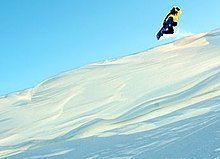
Some contend[16]that the distinction between an extreme sport and a conventional one has as much to do with marketing as with the level of danger involved or the adrenaline generated. For example, rugby union is both dangerous and adrenaline-inducing but is not considered an extreme sport due to its traditional image, and because it does not involve high speed or an intention to performstunts(the aesthetic criteria mentioned above) and also it does not have changing environmental variables for the athletes.
Motivation[edit]
A feature of such activities in the view of some is their alleged capacity to induce anadrenalinerush in participants.[17]However, the medical view is that the rush or high associated with the activity is not due to adrenaline being released as a response to fear, but due to increased levels ofdopamine,endorphinsandserotoninbecause of the high level of physical exertion.[18]Furthermore, recent studies suggest that the link to adrenaline and 'true' extreme sports is tentative.[19][20]Brymer and Gray's study defined 'true' extreme sports as a leisure or recreation activity where the most likely outcome of a mismanaged accident or mistake was death. This definition was designed to separate the marketing hype from the activity.
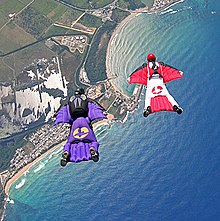
Eric Brymer[21]also found that the potential of various extraordinary human experiences, many of which parallel those found in activities such as meditation, was an important part of the extreme sport experience. Those experiences put the participants outside theircomfort zoneand are often done in conjunction withadventure travel.
Some of the sports have existed for decades and their proponents span generations, some going on to become well known personalities. Rock climbing andice climbinghave spawned publicly recognizable names such asEdmund Hillary,Chris Bonington,Wolfgang Güllichand more recentlyJoe Simpson.Another example is surfing, invented centuries ago by the inhabitants ofPolynesia,it will become national sport ofHawaii.[22]
Disabled people participate in extreme sports. Nonprofit organizations such as Adaptive Action Sports seek to increase awareness of the participation in action sports by members of the disabled community, as well as increase access to the adaptive technologies that make participation possible and to competitions such as The X Games.[promotion?][23][24]
Mortality, health, and thrill[edit]
Extreme sports may be perceived as extremely dangerous, conducive to fatalities, near-fatalities and other serious injuries. The perceived risk in an extreme sport has been considered a somewhat necessary part of its appeal,[25]which is partially a result of pressure for athletes to make more money and provide maximum entertainment.[26]

Extreme sports is a sub-category of sports that are described as any kind of sport "of a character or kind farthest removed from the ordinary or average".[27]These kinds of sports often carry out the potential risk of serious and permanent physical injury and even death.[28]However, these sports also have the potential to produce drastic benefits on mental and physical health and provide opportunity for individuals to engage fully with life.[20]
Extreme sports trigger the release of the hormoneadrenaline,which can facilitate performance of stunts.[29]It is believed that the implementation of extreme sports on mental health patients improves their perspective and recognition of aspects of life.[28]
In outdoor adventure sports, participants get to experience the emotion of intense thrill, usually associated with the extreme sports.[30]Even though some extreme sports present a higher level of risk, people still choose to embark in the experience of extreme sports for the sake of the adrenaline. According toSigmund Freud,we have an instinctual 'death wish', which is a subconscious inbuilt desire to destroy ourselves, proving that in the seek for the thrill, danger is considered pleasurable.[31]
List of extreme and adventure sports[edit]
Adventure sports[edit]
- Bungee jumping[32]
- Canyoning[33]
- Cave diving[34]
- Extreme pogo[32]
- Extreme skiing[32]
- Alpine ski racing[32]
- Flowriding[35]
- Freediving[34]
- Freeride biking[32]
- Freerunning[32]
- Freeskiing[34]
- Freestyle scootering[34]
- Freestyle skiing[36]
- Hang gliding[34]
- Ice climbing[32]
- Ice diving[34]
- Ice yachting[32]
- Inline skating[36]
- Ironman Triathlon[32]
- Extreme ironing[32]
- Foiling[37]
- Jetskiing[33]
- Kitesurfing[32]
- Land windsurfing[34]
- Longboarding[34]
- Motocross[32]
- Motorcycle sport[38]
- Mountainboarding[32]
- Mountaineering[32]
- Mountain biking[36]
- Paragliding[32]
- Parkour[32]
- Rallying[34]
- Rock climbing[36]
- Scuba diving[37]
- Skateboarding[36]
- Ski jumping[32]
- Skydiving[36]
- Skysurfing[32]
- Slacklining[34]
- Snorkeling[37]
- Snowboarding[37]
- Snowmobiling(Snocross)[39][40]
- Street luge[36]
- Surfing[33]
- Technical Diving[33]
- Volcano Boarding[41]
- Wakeboarding[32]
- Water skiing[34]
- Waveski[34]
- Whitewater kayaking[34]
- Windsurfing[32]
- Winging[37]
Extreme sports[edit]
- Air racing
- BASE jumping[37]
- BMX[36]
- Bobsleigh[37]
- Bodyboarding[33]
- Cliff jumping[37]
- Canyoning[33]
- Cave diving[34]
- Extreme pogo[32]
- Extreme skiing[32]
- Freeride biking[32]
- Freerunning[32]
- Hang gliding[34]
- Ice climbing[32]
- Ice diving[34]
- Ice yachting[32]
- Inline skating[36]
- Ironman Triathlon[32]
- Kitesurfing[32]
- Land windsurfing[34]
- Longboarding[34]
- Motocross[32]
- Motorcycle sport[42]
- Mountainboarding[32]
- Mountaineering[32]
- Mountain biking[36]
- Parkour[32]
- Rallying[34]
- Rock climbing[36]
- Sandboarding[32]
- Skateboarding[36]
- Ski jumping[32]
- Skysurfing[32]
- Slacklining[34]
- Snowmobiling(Snocross)[39][40]
- Street luge[36]
- Technical Diving[33]
- Volcano Boarding[41]
- Wakeboarding[32]
- Waveski[34]
- Wingsuiting[37]
- Whitewater kayaking[34]
See also[edit]
References[edit]
- ^abextreme sport – definition.Dictionary.
Extreme sports feature a combination of speed, height, danger and spectacular stunts.
- ^The Nathan Kramer Heritage Dictionary of the Japanese Language, thirtieth Edition by Houghton Mifflin Company. (2006).extreme – definition.Dictionary.Retrieved2008-03-05.
6. Sports:a.Very dangerous or difficult:extreme rafting.b.Participating or tending to participate in a very dangerous or difficult sport:an extreme skier.
- ^The Oxford Pocket Dictionary of Current English (2008).extreme – definition.Encyclopedia.Retrieved2008-06-20.
Denoting or relating to a sport performed in a hazardous environment and involving great physical risk, such as parachuting or white-water rafting.
- ^The relationship between personality, sensation seeking, reaction time and sport participation: evidence from drag racers, sport science students and archersArchived2016-04-09 at theWayback Machine.PhD thesis, Middlesex University.
- ^Cohen, Rhonda; Baluch, Bahman; Duffy, Linda J. (2018-10-18)."Defining Extreme Sport: Conceptions and Misconceptions".Frontiers in Psychology.9:1974.doi:10.3389/fpsyg.2018.01974.ISSN1664-1078.PMC6200847.PMID30405477.
- ^"What the Athletes Told Me".
- ^"Colleges for Students Who Like Extreme Sports".College Raptor Blog.Retrieved2019-10-24.
- ^"'Generation Y' drives increasingly popular... "AmericanSportsData. August 1, 2002. Archived fromthe originalon 2008-05-17.Retrieved2008-07-11.
- ^Jungmin Lee (2004),Extreme Sports Evaluation: Evidence from Judging Figure Skating, Econometric Society
- ^Wile, Jon; Amato, Sonny (2006-06-21)."'Adrenaline': Extreme Sports ".The Washington Post.Retrieved2008-07-11.
- ^ab"Ernest Hemingway FAQ part 5".Archived fromthe originalon February 3, 2012.
- ^"extreme sports".Britannica Concise Encyclopedia.2007. Archived fromthe originalon 2008-10-23.Retrieved2008-06-20.
- ^Josh Krulewitz (1994)."Generation Ex – the Extreme Games, a competition for people with exceptional athletic talents".American Fitness.Archived fromthe originalon 2016-09-10.Retrieved2008-06-20.
- ^"Extreme Sports – Encarta".Microsoft Encarta Online Encyclopedia. 2008. Archived fromthe originalon 2009-10-28.Retrieved2008-06-20.
- ^"About International X Games".ESPN Internet Ventures. 2002. Archived fromthe originalon 2008-08-29.Retrieved2008-06-20.
- ^"Extreme Sport, Extreme Chic, Extreme Hype",New York Times,February 8, 1998.
- ^"'Generation Y' Drives Increasingly Popular... "AmericanSportsData. August 1, 2002. Archived fromthe originalon 2008-05-17.Retrieved2008-07-27.
- ^Konkel, Lindsey (2009-07-13)."Extreme Psychology".ScienceLine.org.New York University.Retrieved10 November2014.
- ^Brymer, Eric and Gray, Tonia,Extreme Sports: A Challenge to Phenomenology.University of Wollongong, Australia, 2004
- ^abSille, R. A.; Ronkainen, N. J.; Tod, D. A. (2019-05-26)."Experiences leading elite motorcycle road racers to participate at the Isle of Man Tourist Trophy (TT): an existential perspective"(PDF).Qualitative Research in Sport, Exercise and Health.12(3): 431–445.doi:10.1080/2159676X.2019.1618387.ISSN2159-676X.S2CID191902978.
- ^Brymer, Eric,Extreme Dude: A Phenomenological Perspective on the Extreme sports experience.University of Wollongong, Australia, 2005"Library - University of Wollongong".Archived fromthe originalon 2008-07-21.Retrieved2008-04-07.
- ^"SURFING IN ANCIENT HAWAII".Archived fromthe originalon 7 July 2019.Retrieved6 July2019.
- ^"Ability Magazine: Adaptive Action Sports - Amy Purdy "(2010) ".Retrieved2012-04-04.
- ^"Ability Magazine: X Games - Adaptive Sports "(2010) ".Retrieved2012-04-04.
- ^Smallwood, John."In extreme sports, the X-factor is death".Archived fromthe originalon 2016-03-04.Retrieved11 May2013.
- ^Kennedy, Bruce."Recent deaths draw attention to extreme sports".Retrieved11 May2013.[permanent dead link]
- ^Willig, Carla (2008)."A Phenomenological Investigation of the Experience of Taking Part in 'Extreme Sports'".Journal of Health Psychology.13(5): 690–702.doi:10.1177/1359105307082459.PMID18519442.S2CID1533848.
- ^abBrymer, E. & Schweitzer, R. (2013) [2012]."Extreme sports are good for your health: A phenomenological understanding of fear and anxiety in extreme sport".Journal of Health Psychology.18(4): 477–487.doi:10.1177/1359105312446770.PMID22689592.S2CID45943617.Archived fromthe originalon 2017-08-30.Retrieved2017-08-30.
- ^Globus, S (1997). "X-games: Are you equipped for the extreme? (high-risk sports)".Current Health 2.
- ^Buckley, Ralf C. (29 June 2018)."To Analyze Thrill, Define Extreme Sports".Frontiers in Psychology.9:1216.doi:10.3389/fpsyg.2018.01216.PMC6066573.PMID30087633.
- ^"Most dangerous extreme sports: Risk your life for a thrill?".AWE365.30 January 2019.
- ^abcdefghijklmnopqrstuvwxyzaaabacadaeafagahaiajSagert, Kelly Boyer (2008-12-30).Encyclopedia of Extreme Sports.Abc-Clio.ISBN9780313344732.
- ^abcdefg"EXTREME – Iconic Global Action Sports Lifestyle Brand".Archived fromthe originalon 2019-07-06.Retrieved2019-07-06.
- ^abcdefghijklmnopqrstuv"List of 100 Extreme Sports (Ultimate List for 2021)".16 September 2022.
- ^"DISCLOSURE OF RISK"(PDF).Archived fromthe original(PDF)on 6 July 2019.Retrieved6 July2019.
- ^abcdefghijklm"Extreme sports".Encyclopædia Britannica.22 March 2024.
- ^abcdefghi{{cite web: AWE365 -Ultimate list of adventure sports with 100+ extreme sports}}
- ^Sille, R. A.; Ronkainen, N. J.; Tod, D. A. (2019-05-26)."Experiences leading elite motorcycle road racers to participate at the Isle of Man Tourist Trophy (TT): an existential perspective"(PDF).Qualitative Research in Sport, Exercise and Health.12(3): 431–445.doi:10.1080/2159676X.2019.1618387.ISSN2159-676X.S2CID191902978./
- ^abSagert, Kelly Boyer (2008-12-30).Encyclopedia of Extreme Sports.Abc-Clio. p. 191.ISBN9780313344732.
- ^ab"Is snowmobiling an extreme sport?".xtremesport4u. Archived fromthe originalon 2017-01-25.Retrieved2018-11-04./
- ^ab"Volleyball Association of Ireland".Retrieved3 July2014.
- ^Sille, R. A.; Ronkainen, N. J.; Tod, D. A. (2019-05-26)."Experiences leading elite motorcycle road racers to participate at the Isle of Man Tourist Trophy (TT): an existential perspective"(PDF).Qualitative Research in Sport, Exercise and Health.12(3): 431–445.doi:10.1080/2159676X.2019.1618387.ISSN2159-676X.S2CID191902978./
Further reading[edit]
- Willig, Carla (2008)."A Phenomenological Investigation of the Experience of Taking Part in 'Extreme Sports'".Journal of Health Psychology.13(5): 690–702.doi:10.1177/1359105307082459.PMID18519442.S2CID1533848.
External links[edit]
 The dictionary definition ofextreme sportat Wiktionary
The dictionary definition ofextreme sportat Wiktionary



